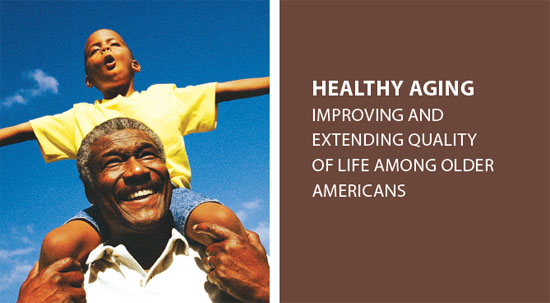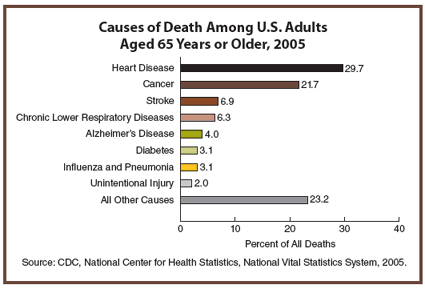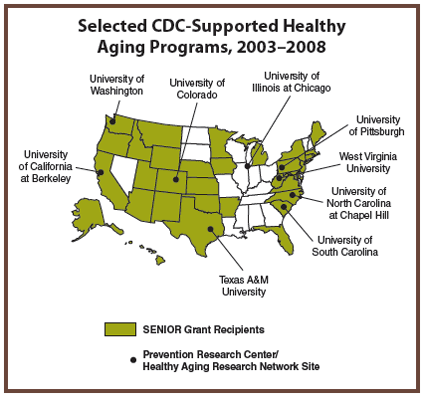 |
|
 |
 |
 |
HEALTHY AGING
Improving and Extending Quality of Life Among Older Americans
At A Glance
2009

The Health and Economic Effects of an Aging Society
By 2030, the number of U.S. adults aged 65 years or older will more than
double to about 71 million. The rapidly increasing number and diversity of
older Americans has far-reaching implications for the U.S. public health
system and will place unprecedented demands on aging services and the
nation’s entire health care system.
For example, Medicare spending has grown about nine-fold in the past 25
years, increasing from $37 billion in 1980 to $336 billion in 2005. If left
unchecked, health care spending will increase 25% by 2030, largely because
of the aging population.
Chronic diseases disproportionately affect older adults and are
associated with disability, diminished quality of life, and increased costs
for health care and long-term care. Today, about 80% of older adults have at
least one chronic condition, and 50% have at least two. These conditions can
cause years of pain and loss of function. Public health efforts can help
Americans avoid preventable illness and disability as they age. Research has
shown that poor health is not an inevitable consequence of aging. Effective
public health strategies currently exist to help older adults remain
independent longer, improve their quality of life, and potentially delay the
need for long-term care.
Critical Opportunities To Improve Older Adults' Health and Quality of Life
Our increased understanding of the critical factors involved in
protecting and promoting the health of older adults has identified emerging
public health issues that need to be addressed, such as the following:
- Promote an up-to-date measure for clinical preventive services. Population-based
data on the use of preventive services recommended for older adults,
such as immunizations and regular health screenings, are currently
monitored individually. A composite measure would better promote the
services, improve data collection, and more effectively guide policy.
- Address depression. Depression affects nearly 7 million older
adults, but many do not receive treatment. Community-based strategies to
effectively screen and treat older adults should be more widely
disseminated.
- Promote caregiving interventions. In 2004, about 34 million
people were providing unpaid care for adult family members, friends, or
neighbors aged 50 years or older. This number will increase dramatically
as baby boomers reach older age. A key public health goal is to
translate policies and strategies known to improve caregiver health and
well-being into widespread practice.
- Address end-of-life issues. What most people want at the end
of their lives is well-documented—to die, as pain-free as possible, at
home with family present and to have their wishes honored. However, many
people are not allowed “to die with dignity.” In response, public health
aims to raise awareness about the value of end-of-life planning and
ensure that individuals and their families have appropriate guidance and
information.

[A text description of this map is also available.]
CDC’s Roles in Promoting Healthy Aging
CDC’s Healthy Aging Program conducts activities designed to provide a
comprehensive approach to helping older adults live longer, high-quality,
productive, and independent lives. The Healthy Aging Program collaborates
with other CDC programs, such as those focused on injury prevention,
disability prevention, and adult immunizations, as well as with key external
groups.
Examples of these activities include the following:
-
Enhance the ability of states and communities to
identify and implement effective strategies, policies, and programs to
promote and protect the health of older adults. CDC supports the
Healthy Aging Research Network (HAN), a consortium of nine Prevention
Research Centers at academic institutions around the country working to
better understand the determinants of healthy aging, identify
interventions that promote healthy aging, and assist in translating
research into sustainable community-based programs.
In 2008, the Healthy Aging Program sponsored “Effective Programs to
Treat Depression in Older Adults: Implementation Strategies for
Community Agencies,” a symposium to assist community-based professionals
in public health, aging services, and mental health networks in
providing science-based depression screening and management for older
adults.
In 2009, a second symposium, “Promoting Environmental and Policy Change
to Support Healthy Aging,” will address the opportunities posed by
environmental and policy strategies.
The Healthy Aging Program recently released Assuring Healthy
Caregivers, A Public Health Approach to Translating Research into
Practice: The RE-AIM Framework, to respond to challenges in
translating science-based caregiver interventions into “real world”
settings. This document helps practitioners and researchers plan,
conduct, and evaluate intervention programs and policies that promote
the health and well-being of caregivers. It also illustrates the
benefits of applying the RE-AIM framework (Reach, Effectiveness,
Adoption, Implementation, and Maintenance) to caregiver intervention
programs, using Alabama’s REACH (Resources for Enhancing Caregiver
Health) II Caregiver Demonstration Project as an example.

[A text description of this map is also available.]
-
Expand efforts to integrate public health and aging
services and enhance outreach for health promotion and disease
prevention for older adults. The Healthy Aging Program aims to
integrate public health’s expertise in research, health tracking, and
prevention programs with the experience and reach of the nation’s aging
services network. For example, through the National Association of
Chronic Disease Directors (NACDD), CDC funds SENIOR (State-Based
Examples of Network Innovation, Opportunity, and Replication) grants in
several states (see map) to assist selected health departments in
working with aging network colleagues to promote integrated strategies
for healthy aging.
The Healthy Aging Program partnered with NACDD in 2008 to release The
State of Mental Health and Aging in America Issue Brief 1: What Do the
Data Tell Us? (http://www.chronicdisease.org/files/public/IssueBrief_TheStateofMentalHealthandAging
inAmerica.pdf). This brief presents national and state data on six
indicators of mental health for older adults. A second brief in 2009
will present interventions addressing depression.
The Healthy Aging Program sponsors The State of Aging and Health in
America report series and interactive Web site (http://www.cdc.gov/aging/saha.htm).
These tools enable public health and aging services professionals,
journalists, and researchers to evaluate key indicators of older adult
health at state and national levels. In 2009, the Web site will be
updated with the most current data.
-
Promote health and preserve health-related quality of
life for older adults within health care and other systems.
Promoting the broader use of preventive services by older adults is a
key public health strategy. A recent analysis showed that in 2004, no
more than 25% of adults aged 50–64 years were up-to-date on
immunizations and cancer screenings recommended by the U.S. Preventive
Services Task Force.
In 2008, CDC collaborated with the American Medical Association and AARP
to develop Building Clinical and Community Bridges to Promote
Preventive Services for Adults Aged 50–64 in the United States. This
tool includes easily referenced national and state data on preventive
services, effective community-based strategies, and “calls to action”
designed to ensure that adults aged 50–64 years receive potentially
lifesaving preventive services.
The Healthy Aging Program, partnered with key collaborators
to fund a scientific examination of the effectiveness of community-based
interventions for treating depression in older adults. Based on these
findings, The Guide to Community
Preventive Services Task Force made three new recommendations concerning
mental health and older adults (http://www.thecommunityguide.org).
Healthy Brain Initiative
In 2007, CDC and the Alzheimer’s Association released The
Healthy Brain Initiative: A National Public Health Road Map to Maintaining
Cognitive Health (http://www.cdc.gov/aging/roadmap). This publication
outlines specific actions for addressing cognitive health, a major public
health issue that is increasingly affecting individuals, communities, and
states. CDC supports several projects including supporting the HAN to
increase understanding of the public’s beliefs about cognitive health
(including those of caregivers and health care providers) and developing and
implementing measures to assess and monitor the impact of cognitive
impairment to guide national and state strategies.
Future Directions
State and local health departments, the aging services
network, and other groups that serve older adults look to CDC to provide
scientific and programmatic expertise and strategies that reduce long-term
care needs and preserve health and quality of life for older adults. In
response, CDC and its partners are working in several areas including the
following:
-
The Healthy Aging Program conducted research to identify
health disparities. They examined the health and characteristics of
American Indian and Alaska Native caregivers and included a “call to
action” in The State of Aging and Health in America 2007 report to
address health disparities among older adults.
-
Working with the NACDD, the Healthy Aging Program
examined state health departments’ needs, priorities, and activities
related to older adult health to better support state-based efforts.
Unrealized Opportunity
There are few public health interventions for which the
benefits are more rigorously documented than immunizations and screening for
chronic diseases. However, the rate of delivery of these potentially
lifesaving preventive services is remarkably low. A recent analysis shows
that in 2004, less than 40% of individuals aged 65 years or older were
up-to-date on immunizations for influenza and pneumococcal disease and
screenings for breast, cervical, and colorectal cancers. To a large extent,
the overwhelming responsibility for delivery has fallen at the door of the
already overburdened physician’s office. Key strategies for improving and
protecting the health of older adults include broadening the use of
preventive services and establishing coordinated, convenient,
community-based sites for delivery of services.
Taking Action
The Sickness Prevention Achieved through Regional
Collaboration (SPARC) program, long active in a 4-county area of New
England, has shown documented success in enhancing the delivery rates of
influenza and pneumococcal vaccines and screenings for breast, cervical, and
colorectal cancers among older adults. SPARC’s approach is to catalyze and
guide coordination and collaboration among health care providers, local
government agencies (e.g., local health departments and area agencies on
aging), community groups, and others to tap existing community resources in
broadening the delivery of preventive care.
SPARC itself does not deliver clinical preventive services
but rather serves as the “glue” in facilitating and monitoring
community-wide efforts. SPARC’s innovative strategies include bundling
preventive services, such as providing appointments for mammography to women
attending flu shot clinics, and pioneering Vote and Vax campaigns that make
immunizations available at polling places on election days.
An Effective Community-Based Approach
 In fall 2006, the SPARC program was piloted for the first time in two
metropolitan counties in Atlanta, Georgia under the auspices of the Atlanta
Regional Commission’s Area Agency on Aging. Recognizing the benefits of the
SPARC approach, nine metropolitan Atlanta counties have now joined the SPARC
initiative. These counties have established coalitions with other county
offices on aging and are using local knowledge of their communities and a
network of community-based collaborators to develop innovative,
community-tailored interventions. The SPARC model’s success in broadening
the delivery of critical preventive services should be considered by other
communities around the country seeking to improve and protect the health of
their older residents
In fall 2006, the SPARC program was piloted for the first time in two
metropolitan counties in Atlanta, Georgia under the auspices of the Atlanta
Regional Commission’s Area Agency on Aging. Recognizing the benefits of the
SPARC approach, nine metropolitan Atlanta counties have now joined the SPARC
initiative. These counties have established coalitions with other county
offices on aging and are using local knowledge of their communities and a
network of community-based collaborators to develop innovative,
community-tailored interventions. The SPARC model’s success in broadening
the delivery of critical preventive services should be considered by other
communities around the country seeking to improve and protect the health of
their older residents
Ensuring State Readiness for an Aging Society: Formulating a Roadmap
Public Health Problem
The nation’s public health network can anticipate substantially greater
challenges—and opportunities—to promote and preserve the health of older
adults. The aging of baby boomers will place unprecedented demands on the
nation’s public health and aging services networks. One of CDC’s top
priorities is ensuring that these networks are more closely linked and are
ready to take action by sharing and building on their respective expertise,
outreach, and data. Establishing a statewide plan for healthy aging, as was
done in New Jersey with CDC support, is a critical foundational element for
meeting the challenges of an aging society.
Taking Action
In 2007, New Jersey produced a Blueprint for Healthy Aging in New Jersey
using a CDC Opportunity Grant under the SENIOR grant program. The
Blueprint, which was critically needed by New Jersey’s Department of
Health and Senior Services (DHSS), is providing a first-ever compilation of
easily referenced, county-level material designed to do the following:
-
Educate key decision makers and others on the health
status of older New Jersey residents.
-
Raise awareness of health benefits through the adoption
of healthy behaviors.
-
Highlight evidence-based health promotion programs that
can be supported and replicated throughout the state.
-
Provide the public health and aging services networks
with needed data to effectively plan, implement, and evaluate health
promotion efforts directed towards older adults.
A broad base of partners worked closely together to develop the report which
was in itself a key accomplishment: several internal offices within DHSS;
representatives from local health departments, county offices on aging,
senior centers, hospital wellness programs, and other local provider
agencies; and parish nurses. Internal DHSS linkages were strengthened and
working partnerships were formed with traditional and nontraditional
partners.
With CDC support, the New Jersey DHSS took action to ensure that the content
of the landmark Blueprint was complete, accurate, up-to-date, and
useful. For example, a survey was conducted to obtain information on
existing data, local health promotion programs, and current strategies
pursued by local agencies to promote older adult health. To guide and assist
individual communities in their efforts to improve older adult health,
information on key health behaviors for older adults and examples of model
programs and strategies were identified, compiled, and highlighted in the
Blueprint.
The publication used personal success stories shared by residents from each
New Jersey county that recounted how healthy behaviors—even if initiated in
older age—had improved their lives. Innovative marketing and dissemination
strategies were showcased in the Blueprint to help jumpstart
community efforts in health promotion for older adults.
Implications and Impact
New Jersey’s Blueprint has served to focus, coordinate, and catalyze
community-based efforts throughout the state in support of healthy aging. To
facilitate widespread dissemination of the Blueprint, DHSS staff
trained community partners in using the tool to raise awareness, develop
policy, and expand health promotion programming for older adults. Among
those trained were the directors of the county offices on aging and public
health officers in each of New Jersey’s 21 counties.
The success of the Blueprint extended further by enabling New Jersey
to successfully compete for a grant from the U.S. Administration on Aging to
build a statewide system to support chronic disease self-management. The
Blueprint has also served as the catalyst for a state-based program
funding community-based, minority organizations to implement chronic disease
self-management programs. Given its breadth, depth, and scope, the tool
continues to catalyze and facilitate the work of community-based agencies
and organizations in their efforts to promote and preserve the health of
their older residents.
Back to top
Related Materials
Back to top
|
For more information please contact
Centers for Disease Control and Prevention
National Center for Chronic Disease Prevention and Health Promotion
4770 Buford Highway NE, Mail Stop K–45, Atlanta, GA 30341-3717
Telephone: 770-488-5464 • Fax: (770) 488-8488
E-mail: cdcinfo@cdc.gov • Web:
http://www.cdc.gov/aging
|
|
 One or more documents on this Web page is available in Portable Document Format
(PDF). You will need Acrobat
Reader (a free application) to view and print these documents.
One or more documents on this Web page is available in Portable Document Format
(PDF). You will need Acrobat
Reader (a free application) to view and print these documents.
Page last reviewed: January 15, 2009
Page last modified: January 15, 2009
Content source: National Center for
Chronic Disease Prevention and Health Promotion
|
 |
![]() One or more documents on this Web page is available in Portable Document Format
(PDF). You will need Acrobat
Reader (a free application) to view and print these documents.
One or more documents on this Web page is available in Portable Document Format
(PDF). You will need Acrobat
Reader (a free application) to view and print these documents.